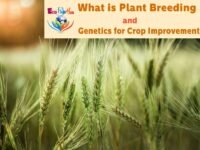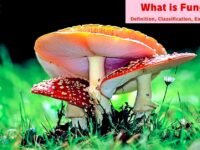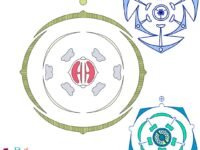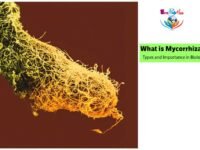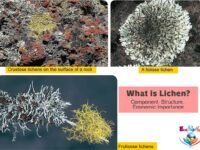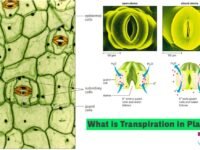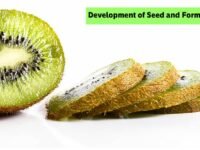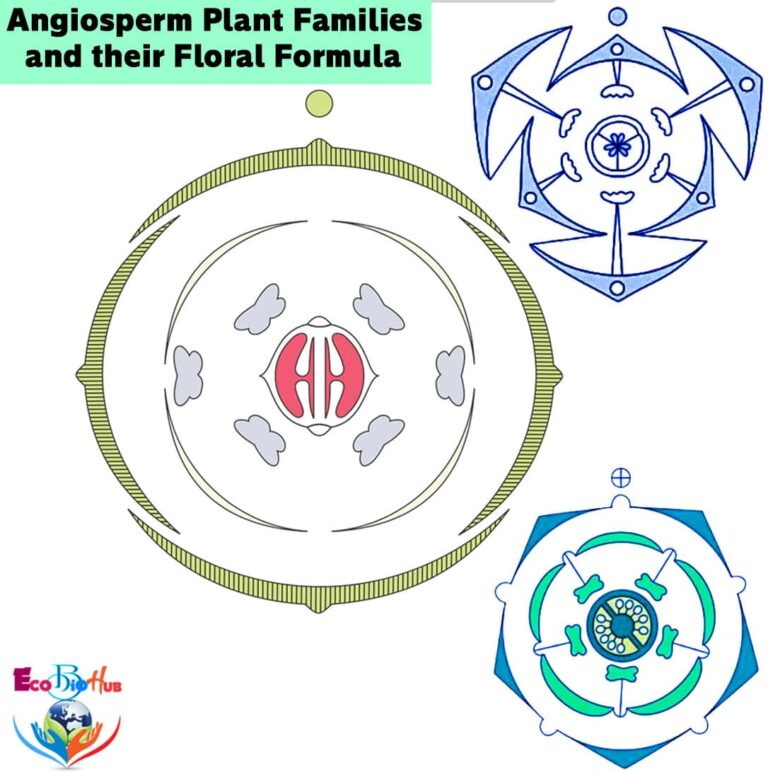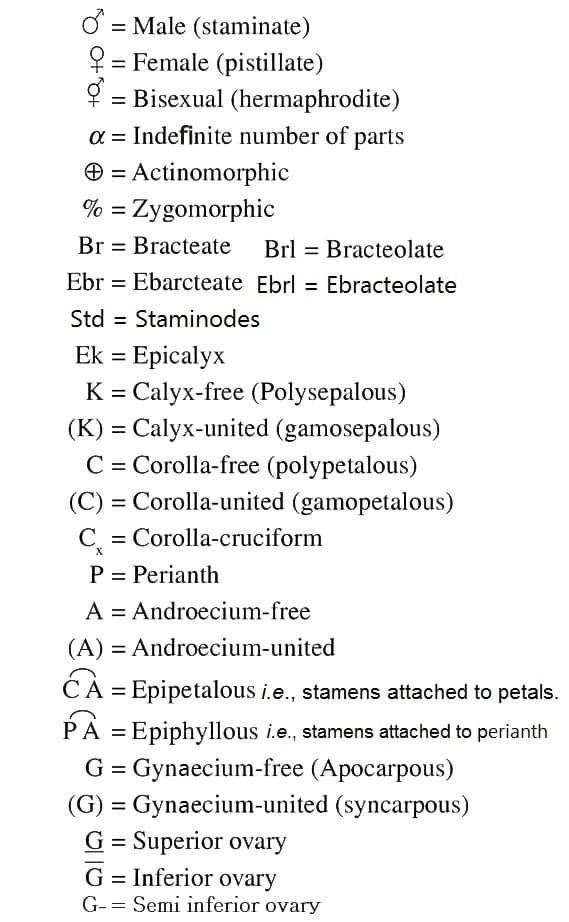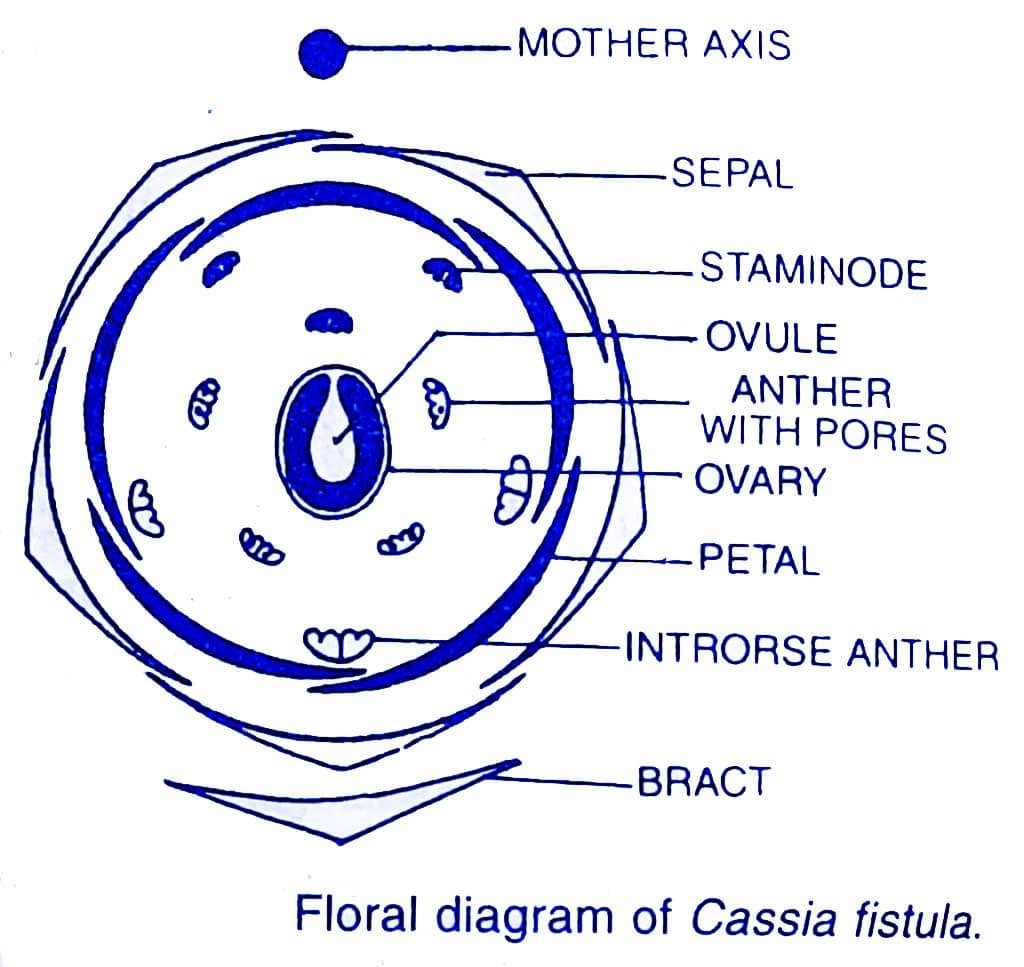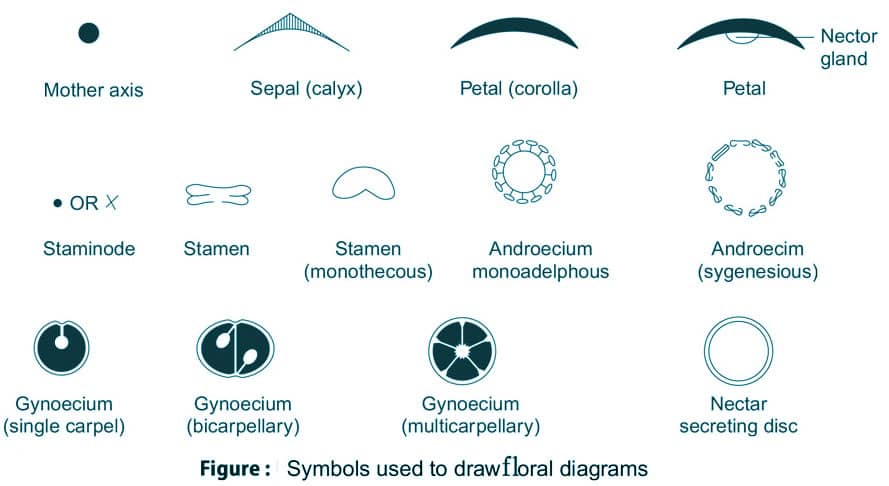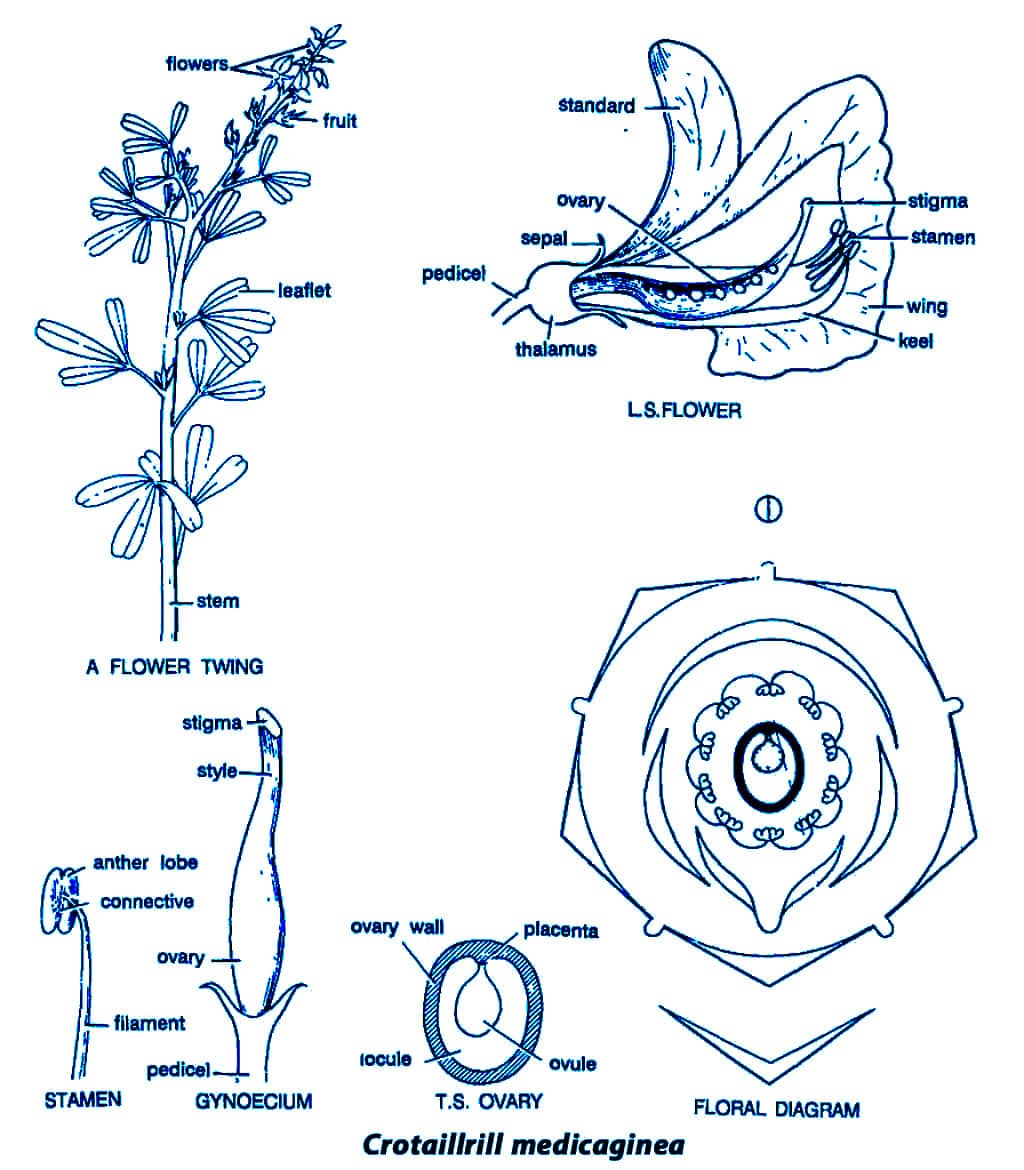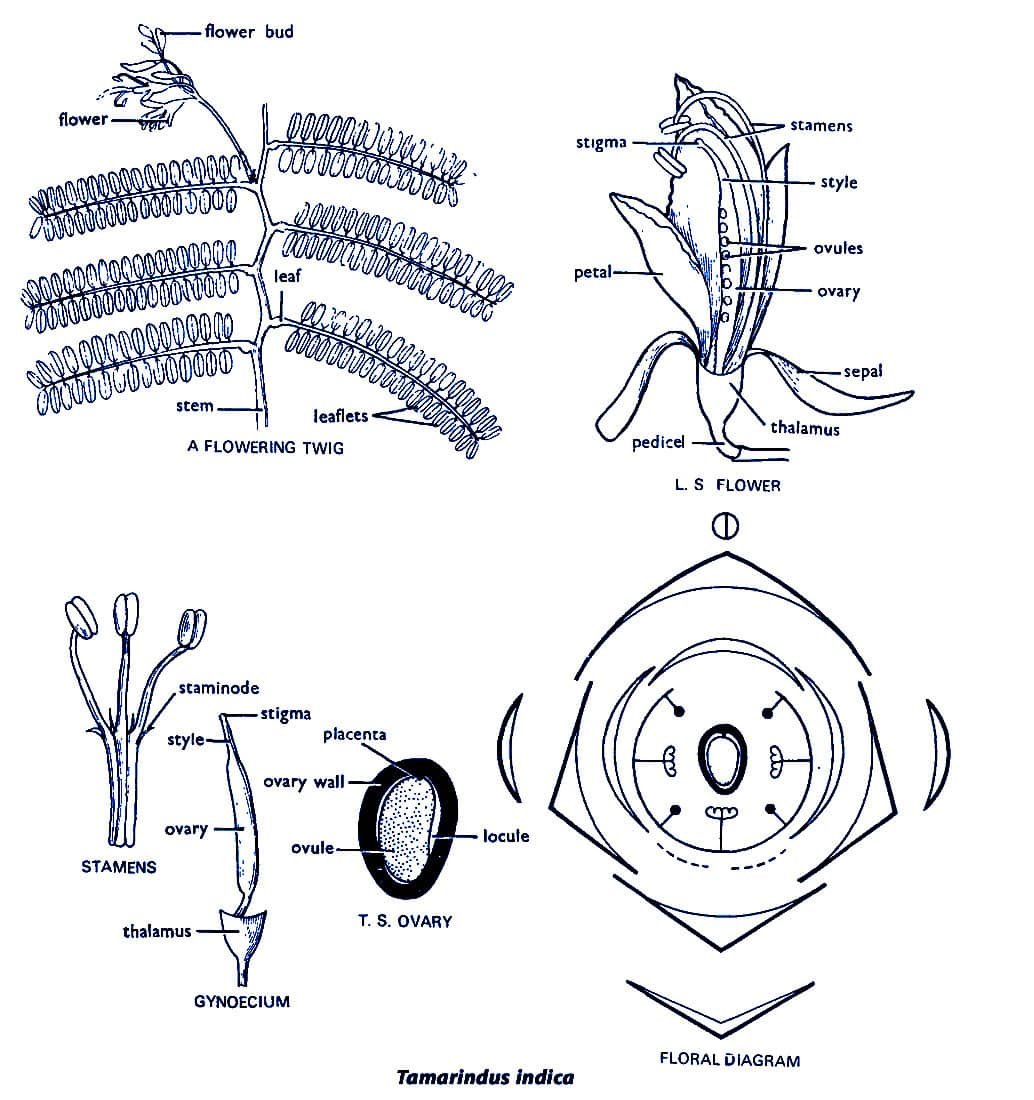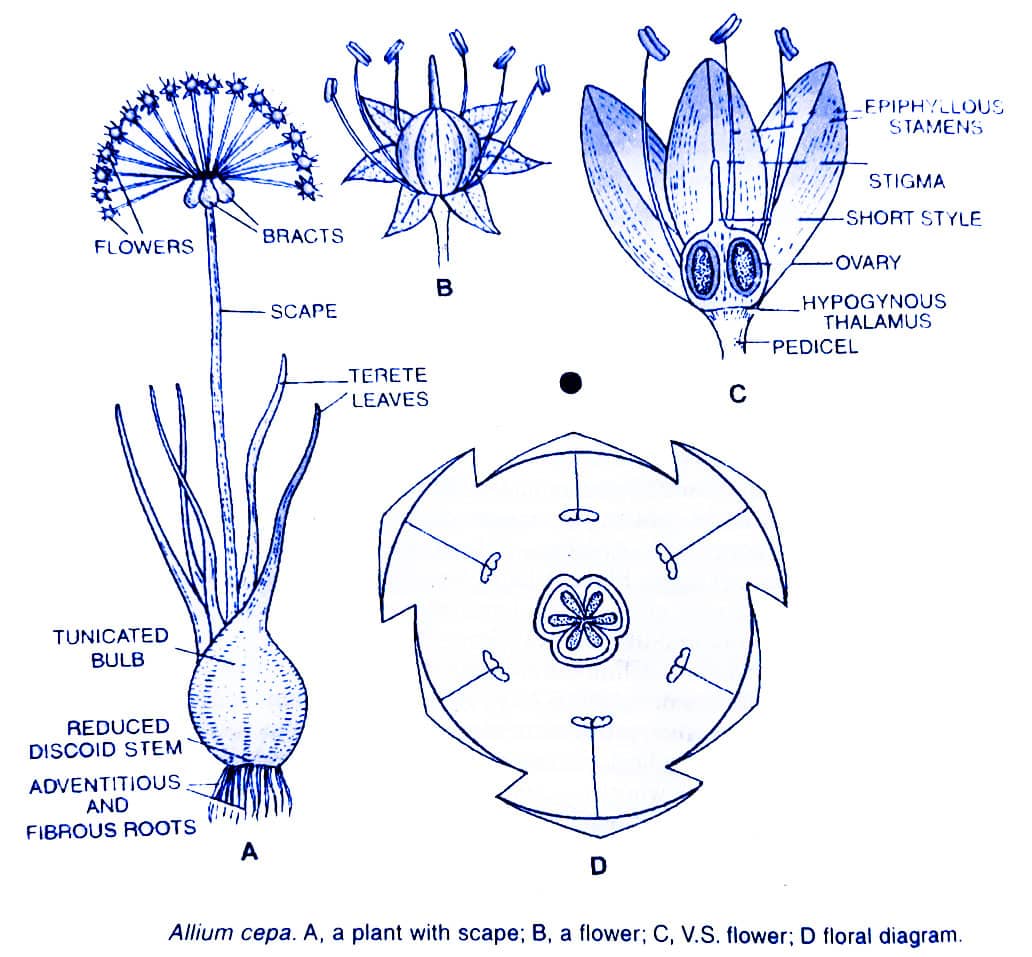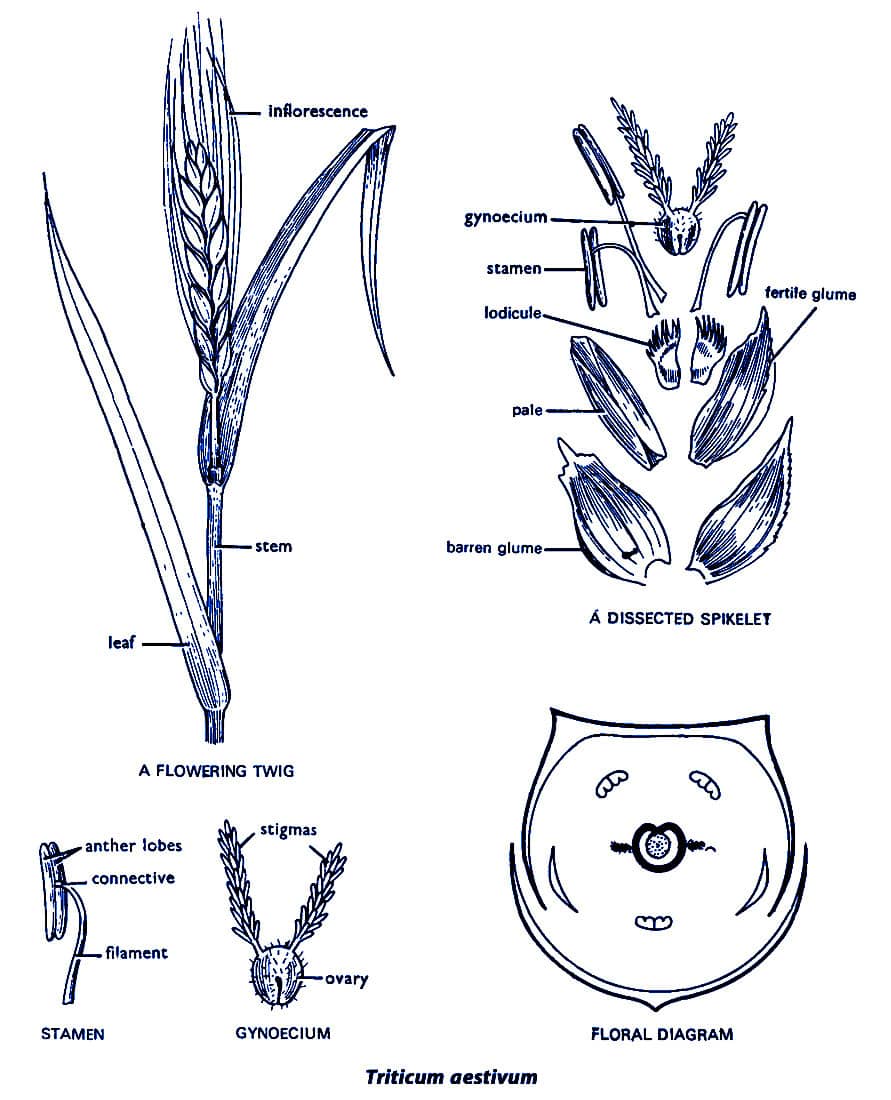In this tutorial, we have discussed ‘Angiosperm Plant Families and their Floral Formula‘.
Flowering plants are described in sequential order of morphological characters, like habit, habitat, root, stem, leaves, inflorescence, flower, fruit, and seed of the plant. On the basis of floral characters, a floral diagram and a floral formula are drawn. By the observed characters, the plant is identified and assigned to its correct systematic position (class, series, order, family) in a system of classification. Floral characters are used as a basis of classification as the floral features are conservative as compared to vegetative characters.
► Read More: Development of Seed and Formation of Fruit ► Read More: Why Seed Dispersal is important? Agents of Seed Dispersal ► Read More: What is Pollination? Definition, Types, Agents, Significance ► Read More: Reproduction in Plants : Sexual and Asexual reproduction ► Read More: What is Transpiration in Plants? ► Read More: Inflorescence Types || Racemose, Cymose, Mixed, Specialized ► Read More: Different Types of Fruits in Biology & its Importance
TABLE OF CONTENTS
Floral Formula
— Definition: A floral formula (FF) is a symbolic representation of floral symmetry, presence or absence, number, cohesion, and adhesion of various parts.
A floral formula informed us —
➢ bracteate or ebracteate nature and the symmetry of the flower,
➢ sexuality, number, and union of sepals, petals, stamens, and carpels;
➢ the insertion of stamens either on the thalamus or fusion with the petals (or perianth); and
➢ the superior and inferior position of the gynaecium.
—They are all represented by symbols which are as follows:
— Each letter (K = calyx, C = corolla, A = androecium or G = gynaecium) is followed by the number of parts in its particular group, e.g., K5 means 5 sepals in the calyx, C5 means 5 petals in the corolla, A4 means 4 stamens in androecium, G2 means 2 carpels in gynaecium.
— If the number is much more, the sign of infinity ‘∞’ is used, e.g., A∞ (indefinite or numerous stamens).
— More than one whorl or group of a type of floral organ is represented by using the sign plus and writing the actual number of parts in each group or whorl, e.g., K2+2 — (4 sepals in two groups or whorls of two each).
— If the floral parts of a series are united in one or more groups, the number of parts is written within brackets, e.g., K(5) (Calyx number 5, gamosepalous), A(9) + 1 (Androecium diadelphous, one group containing 9 fused stamens, the other group having single free stamen).
— An arc between the two organs marked above them indicates their adhesion, e.g.,
| epipetalous condition i.e., adhesion of corolla (petals) and androecium (stamens) | |
| epiphyllous condition i.e., adhesion of perianth (tepals) and androecium (stamens) |
— In case of the inferior ovary, a line (or bar) is placed above the G number; similarly, if a superior ovary, it is placed below it, e.g.,
| Gynaecium bicarpellary, syncarpous, superior | |
| Gynaecium bicarpellary, syncarpous, inferior |
— If a group of organs is missing, symbol zero (0) is put after its code. e.g.,
| A0 | Sterile stamen (staminode) |
| G0 | Sterile carpel (pistillode) |
— Some of the floral formulae of the common flowers are as follows:
Actinomorphic;
Bisexual;
Calyx – 5, free;
Corolla – 5, free;
Androecium – numerous, free;
Gynaecium – polycarpellary, apocarpous, superior).
(Ebracteate;
Actinomorphic;
Bisexual;
Calyx-4, polysepalous, in two whorls of two each;
Corolla-4, polypetalous, cruciform;
Androecium – 6, polyandrous, tetradynamous in two whorls, one with two, the second with four;
Gynaecium – Bicarpellary, syncarpous, superior).
— Limitations of Floral Formula
The floral formula has its own limitations. It does not give information about (i) asestivation (ii) relationship with members of the same or different series (iii) placentation (iv) chambers of the ovary (v) nectaries, etc.
Floral Diagram
— Definition: The floral diagram is a diagrammatic representation of the theoretical transverse section and the ground plan of a floral bud in relation to the mother axis which lies at the posterior side.
— From the floral diagram, we can learn a flower with the following details:
➢ Symmetry, regular or irregular, and Sexuality of the flower.
➢ Number of floral parts in each whorl.
➢ Position of the floral parts
➢ Fusion among the similar parts (cohesion or connation) and with dissimilar parts (adhesion or adnation) of the flower.
➢ Aestivation of the floral parts,
➢ Relation between the different floral organs, bithecous or monothecous nature of anthers, placentation, presence of nectaries, disc below the ovary, etc.
In floral diagram the floral whorls are represented by concentric circles, sepals on the outside, then petals, stamens, and carpels towards the inner sides, respectively. The parts are represented by sections, drawn in respective circles at positions corresponding to their actual position in the flower. Above the diagram a small circle is drawn to indicate the mother axis. Mother axis is not drawn in case of terminal flowers. If parts of the same whorl are fused, their edges are to be drawn connected. In case the parts of different whorls are joined, viz., stamens to petals (epipetalous condition), linking lines are drawn between the parts concerned. Stamens and ovary are drawn by transverse sections.
Sepals and petals are illustrated by arcs; the arcs of sepals have sharp points on the outer middle region while the arcs of petals are shown as smooth and solid; bract is shown by an arc on the anterior side, while bracteoles by arcs on the sides. Stamens by double kidney-shaped symbol (bithecous anther) and single kidney shaped symbol (monothecous anther); the gynaecium is shown as is observed in a transverse section. Usually, the basal position of the floral parts is shown in the floral diagram.
Flowering Plant Families
DICOTYLEDONAE
FAMILY – FABACEAE (PAPILIONACEAE / PEA FAMILY)
■ Systematic Position
Class – Dicotyledonae
Subclass – Polypetalae
Series – Calyciflorae
Order – Rosales
Family – Fabaceae
■ Distribution
It is commonly called as Pea family or Bean family.
It includes 420 genera and 7000 species, In India, the family is represented by 100 genera and with 754 species.
The family was previously considered subfamily papilionoiodeae or papilionatae of family leguminosae (the other subfamilies are caesalpiniaceae and mimosaceae). It is cosmopolitan and is economically highly important because of yield of pulses.
■ Vegetative Characters
► Habit: Herbs (e.g., Melilotus), shrubs (e.g., Tephrosia), climbers (e.g., Pisum, Lathyrus), twiners (e.g., Lablab), and trees (e.g., Dalbergia) found in mesophytic, xerophytic, or halophytic habitats. Aeschynomene is aquatic.
► Root: Tap root system, much branched, nodulated or tubercled. Nodules contain nitrogen fixing bacteria of the genus Rhizobium.
► Stem: Herbaceous or woody, erect, twining (e.g., Lablab) or climbing (e.g., Pisum), stem branches are modified into thorns in Alhagi pseudalhagi (= A. maurorum, Camel Thorn, vern. Jawasa), solid or fistular, cylindrical or angular, may be hairy.
► Leaves: Cauline and ramal, alternate (rarely opposite or whorled), rarely simple (e.g., Crotalaria), generally pinnate compound, stipulate, stipules foliaceous in Lathyrus aphaca (Wild Pea), leaf base pulvinate, leaves (e.g., Lathyrus aphaca) or leaflets (e.g., Pisum sativum, Lathyrus odoratus) modified into tendrils, two lateral leaflets of Telegraph Plant (Desmodium motorium or D. gyrans) show autonomous movements.
■ Floral Characters
► Inflorescence: Raceme, spike, or rarely solitary.
► Flower: Bracteate or ebracteate, rarely bracteolate (e.g., Arachis), pedicellate or sessile, complete, perfect, irregular, zygomorphic, papilionaceous, perigynous or occasionally hypogynous.
► Calyx: 5, gamosepalous, usually campanulate, lobes unequal, rarely tubular (e.g., Cyamopsis), aestivation imbricate, odd sepal anterior, may be persistent, inferior.
►Corolla: 5, polypetalous, aestivation descending or vexillary imbricate, papilionaceous (butterfly-shaped) with five unequal petals– posterior largest petal called standard or vexillum which overlaps two smaller lateral petals called wings or alae, the latter overlap a boat-shaped structure called keel or carina which is formed by the two anterior petals fused lightly on the anterior side, lateral and anterior petals are scale-like in Erythrina indica (Indian Coral Tree).
► Androecium: 10, usually diadelphous (1 + 9 in Lathyrus, 5 + 5 in Aeschynomene) or monadelphous (9 in Dalbergia, 10 in Arachis and Erythrina indica), rarely free (e.g., Sophora), nectar glands often present on the inner bases of filaments, dehiscence longitudinal, inferior.
► Gynaecium: Monocarpellary, ovary superior unilocular with marginal placentation, ovules many in two alternate rows, style bent, stigma simple or capitate.
► Fruit: Legume or lomentum.
►Seed: One to many, with or without scanty endosperm.
■ Floral Formula of Fabaceae
(01) Presence of nodulated roots.
(02) Inflorescence racemose.
(03) Perigynous flowers.
(04) Flower zygomorphic and papilionaceous.
(05) Calyx 5, gamoespalous with odd sepal anterior.
(06) Corolla 5, petals unequal and differentiated into standard, 2 alae and a keel or carina made up of two partially fused petals. The petals are arranged in descending imbricate fashion.
(07) Androceium commonly diadelphous (1 + 9 or 5 + 5) or monadelphous (10 or 9).
(08) Gynoecium monocarpellary, ovary unilocular with marginal placentation.
(09) Fruit a legume or lomentaceous pod.
■ Economic Importance
► Food (Pulses): A number of legumes or pulses are obtained from fabaceae (papilionoideae) —
— Broad bean (Vicia faba, vern. Bakla),
— Sword Bean (Canavalia gladiata, vern. Bara Sem),
— Soyabean (Glycine max),
— Kidney Bean (Phaseolus vulgaris, vern. Farazbin),
— Cowpea (Vigna unguiculata = V. sinensis, vern. Lobia, Chholia),
— Butter bean or Lima bean (Phaseolus luntas, vern. Sem, Lobia),
— Lablab (Lablab purpureus = Dolichos lablab vern. Sem),
— Pea (Pisum sativum),
— Gram (Cicer arietinum),
— Lentils (Lens culinaris = L. esculenta, vern. Masur),
— Green Gram (Vigna radiata = Phaseolus radiatus = P. aureus, vern. Mung),
— Black Gram (Vigna mungo = Phaseolus mungo, vern. Urd),
— Mat Bean (Vigna aconitifolia = Phaseolus aconitifolius, vern. Moth),
— Pigeon Pea (Cajanus cajan, vern. Arhar).
► Fodder:
— Alfalfa (Medicago sativa, vern. Lusan),
— Indian Clover (Melilotus indica, vern. Senji),
— Guar (Cyamopsis tetragonaloba),
— Berseem (Trifolium alexandrium) and
— Shaftal or Shatala (Trifolium resupinatum).
► Oils: They are extracted from seeds of
—Groundnut or Peanut (Arachis hypogea)
— Pongam oil tree (Pongamia pinnata)
—Soybean (Glycine max).
Roasted groundnut seeds are eaten.
►Soil Fertility: Nodule bearing papilionaceous plants increase nitrogen content of the soil. Therefore, they are used in crop rotation and green manuring, e.g., Crotalaria, Sesbania, Cyamopsis.
►Fibers: They are obtained from the stems of Crotalaria juncea (Sunn Hemp) and Sesbania species. The fibers are used in making cordage, sacks, nets, tissue paper, mats, canvas, etc.
► Dyes:
— Formerly indigo was obtained from the leaves of Indigofera tinctoria and I. suffruticosa. The leaves contain a colourless chemical which on exposure to air turns bluish.
— A blood red dye is got from the wood of Pterocarpus santalinus (Red Sandal Wood, Lal chandan).
— A dye is also obtained from Dalbergia species.
► Gum: Cyamopsis tetragonaloba yields guar gum which is employed in pharmaceuticals, explosives, ceramics, dyes, textiles, paper, plastics and photography. Gum is also secreted by Butea monosperma and Astragalus gummifer. It has medicinal use.
► Medicines:
— The roots of Glycyrrhiza glabra (Liquorice, vern. Mullatthi) are used as demulcent, expectorant and in treating gastric ulcers. Their extract is also used to flavour medicines and tobacco. It is added to chewing gum for flexibility, chocolates and candies to stabilise fat. For a similar purpose it can be added to shoe polishes and in the etching solution for photomicrographic work, Glycyrrhizin, a glycoside of the root, is 50 times sweeter than sugar.
— The seeds of Butea monosperma (Flame of the Forest, vern. Dhak) have antifungal and anthelmintic properties.
— Seeds of Psoralea corylifolia (vern. Babchi) are anthelmintic, diuretic and capable of curing skin diseases including leucoderma.
— Fresh leaf juice of Abrus precatorius (Jeweller’s Weights, Ratti) is useful in treating leucoderma.
— Juice of flowers of Sesbania grandiflora improves eyesight.
► Cork: It is obtained from Aeschynomene aspera (Indian Cork, vern. Sola).
► Jeweller’s Weights: The seeds of Abrus precatorius (a climber) are employed as weights by jewellers.
► Timber:
— Dalbergia sisso (Sisso),
— Dalbergia latifolia (Indian Rosewood) and other species,
— Pterocarpus marsupium (Indian Kino),
— Butea monosperma (vern. Dhak).
► Ornamentals:
— Lathyrus ordoratus (Sweet Pea),
— Clitoria ternata (Butterfly Pea),
— Colutea sp.,
— Lupinus sp.
FAMILY – SOLANACEAE (POTATO FAMILY)
■ Systematic Position
Class – Dicotyledonae
Subclass – Gamopetalae
Series – Bicarpellatae
Order – Polemoniales
Family – Solanaceae
■ Distribution
It is a large family, commonly known as the “potato family”. The family is represented by about 90 genera and 2800 species, out of which In India, there are 15 genera and 88 species in India. The plants occur widely in subtropical, tropical, and temperate regions.
■ Vegetative Characters
► Habit: Mostly Herbs, a few shrubs, rarely soft trees (e.g., Solanum grandiflorum or Potato Tree), or climbers (e.g., Solanum jasminoides or Potato Vine).
► Root: Taproot system.
► Stem: Erect, rarely climbing (e.g., Solanum jasminoides) or prostrate (e.g., Solanum surattense), herbaceous or woody, solid or fistular, glabrous hairs or prickles often present, stem tubers occur in Solanum tuberosum (Potato), prickly in Solanum surattense.
► Leaves: Cauline and ramal, alternate in the vegetative region and become subopposite in the floral region, exstipulate, sessile or petiolate, hairy, simple lobed or pinnately divided, pinnatisect in Tomato, venation unicostate reticulate, variegated in Solanum jasminoides.
■ Floral Characters
► Inflorescence: Axillary or extra-axillary helicoid or umbellate cyme, rarely solitary axillary (e.g., Petunia) or terminal (e.g., Datura).
► Flower: Ebracteate or bracteate, pedicellate, complete, perfect, regular, actinomorphic, rarely zygomorphic (e.g., Salpiglossis, Schizanthus), hypogynous, pentamerous in the outer three whorls, cyclic.
► Calyx: 5, gamosepalous campanulate or tubular, persistent, accrescent (enlarging in fruit, e.g., Physalis, Withania), aestivation valvate, hairy, inferior.
► Corolla: 5, gamopetalous, variously shaped, campanulate, tubular infundibuliform, rotate, bilabiate in Schizanthus, plicate or folded like a fan in the bud, aestivation valvate inferior.
► Androecium: 5, rarely 4, (e.g., Salpiglossis) or 2 (Schizanthus), free, epipetalous, often unequal, anthers bithecous, basifixed or dorsifixed, dehiscence longitudinal (e.g., Petunia) or porous (e.g., Solanum), inferior.
► Gynaecium: Bicarpellary, syncarpous, ovary superior, carpels placed obliquely, generally bilocular (2-4 locular in Tomato, 4-locular in Datura due to false septa), placentation axile, ovules many in each loculus, placentae swollen, a nectariferous disc or lobes may be present, stigma capitate or lobed.
► Fruit: A many seeded berry (e.g., Tomato) or capsule (e.g.. Datura).
► Seed: Endospermic with a straight or curved embryo.
■ Floral Formula of Solanaceae
■ Diagnostic Characters
(01) Aerial parts hairy.
(02) Bicollateral vascular bundles in the stem.
(03) Leaves alternate in the vegetative region but sub-opposite in the floral region.
(04) Calyx 5, gamosepalous, persistent.
(05) Corolla 5, gamopetalous, often plicate in the bud.
(06) Androecium 5, polyandrous and epipetalous.
(07) Gynoecium bicarpellary and syncarpous.
(08) Ovary placed obliquely.
(09) Placentation is axile with swollen placentae.
(10) Fruit berry or capsule.
■ Economic Importance
► Vegetables: Potato (Solanum tuberosum) and Tomato (Lycopersicon lycopersicum = Lycopersicum esculentum) are the most common articles for cooking. Vegetables are also obtained from Brinjal (Solanum melongena) and Bell Pepper (Capsicum frutescens var. grossum, vern. Shimla Mirch).
► Fruits: The fruits of some Physalis species (e.g., Physalis peruviana, Gooseberry, vern. Rasbhari) are edible.
► Spices: Chillies form the common spice. They are the fruits of Capsicum frutescens or C. annuum.
► Tobacco: It comes from the dried and cured leaves of Nicotiana tabacum and N. rustica. Tobacco is considered to be fumigatory, chewed, smoked, or snuffed. Tobacco is intoxicant and stimulant but is habit forming and increases the incidence of heart trouble, lung cancer, gum cancer, impotency in males, and infant deformities in smoking mothers.
► Medicines:
— Atropa belladona (Deadly Nightshade, vern. Suchi) and Atropa acuminata (vern. Angurshafa) yield belladona for relieving pain externally, cough and excessive perspiration internally and atropine for dilating pupil. Atropine sulphate stimultes perspiration and decreses sercretion from nose, mouth, and bronchial regions.
— Henbane (Hyoscyamus niger, vern. Khurasani Ajwain) yields a sedative while Datura stramonium (Jimson Weed) gives an alkaloid called stramonium for relaxing bronchial muscles.
— Roots of Withania somnifera (Ashwagandha) are used to cure rheumatism and general weakness.
— Fruits of Withania coagulens (which are commonly used in preparing cheese) are useful in liver complaints and asthma.
— Different parts of Solanum surattense (= S. xanthocarpum. vern. Kandiali, Mamoli) are used for curing cough, asthma, bronchitis, fever, and leucoderma.
— Water left after boiling Potato tubers is supposed to cure skin burns and pimples.
► Ornamentals: A number of plants are grown as ornamentals, e.g., Petunia, Schizanthus (Butterfly Flower), Cestrum nocturnum (Night Jasmine), Brunfelsia hopeana (Yesterday-today-tomorrow). Datura, etc.
FAMILY – CRUCIFERAE OR BRASSICACEAE (MUSTARD FAMILY)
■ Systematic Position
Class – Dicotyledonae
Subclass – Polypetalae
Series – Thalamiflorae
Order – Parietales
Family – Brassicaceae
■ Distribution
The plants of this family are cosmopolitan in distribution, although mostly in temperate or cold regions. Important plants of this family in India are – Brassica, Raphanus, Iberis (Candytuft), Nasturtium, etc.
■ Vegetative Characters
► Habit: Plants are mostly annual or perennial herbs. A pungent watery juice having sulphur containing enzyme is present in plants.
► Root: Taproot which becomes fleshy due to storage of food materials.
The presence of oil-secreting glands containing myrosin enzyme is an important anatomical feature.
► Stem: Erect, cylindrical, hairy or glabrous herbaceous or rarely woody.
► Leaves: Radical, cauline and ramal, alternate or subopposite, exstipulate with sheathing leaf base sessile, simple or rarely compound.
■ Floral Characters
► Inflorescence: Generally corymb or corymbose raceme (raceme with pedicels of different lengths).
► Flower: Generally ebracteate, pedicillate, bisexual or hermaphrodite, actinomorphic (rarely zygomorphic as in Iberis), hypogynous, tetramerous.
► Calyx: 4 sepals – 2+2, i.e., in two whorls of two each, outer – sepals are antero-posterior , polysepalous, imbricate.
► Corolla: 4 petals, polypetalous, cruciform, i.e., arranged in cross shaped manner, petals are clawed, sometimes petals may be replaced by stamens (as in Capsella bursa-pastoris). Petals reduced or absent in Lepidium.
► Androecium: 6 stamens, polyandrous, tetradynamous condition, i.e., 4 + 2 or in two whorls, 4 inner long and 2 outer short, anthers dithecous and introrse, anthers basifixed or dorsifixed, dehiscence longitudinal.
► Gynaecium: Bicarpellary, tricarpellary (e.g., Lepidium), tetracarpellary (e.g., Tetrapama), syncarpous, ovary-superior, unilocular with parietal placentation. Two carpels are placed side by side or transversely. At maturity, the ovary becomes bilocular due to the formation of false septum (replum), ovules many, style short, stigma-simple or bifid.
► Fruit: Siliqua (dry dehiscent fruit formed by bicarpellary syncarpous gynaecium with replum) or silicula (when siliqua is condensed) or rarely lomentum (Raphanus).
► Seed: Non-endospermic often oily.
■ Floral Formula of Cruciferae / Brassicaceae
■ Diagnostic Characters
(01) Oil secreting glands or cells in vegetative parts of the plants.
(02) Inflorescence – corymb.
(03) Cruciform (x-shaped) corolla-hence named ‘Cruciferae‘.
(04) Tetradynamous condition of androecium. Green nectaries occur at the base of the stamen.
(05) Biarpellary, syncarpous gynaecium with parietal placentation.
(06) Presence of false septum or replum in the ovary.
(07) Fruit is siliqua.
■ Economic Importance
The members of this family are sources of vegetables (food), oils, medicines, spices and some are ornamentals.
► Vegetables (Food)
— Brassica campestris var. sarson (Pili Sarson): Tender shoots are used as a source of vegetables (Sarson Ka Saag).
— Brassica oleracea var. botrytis (Cauliflower or Phool gobhi): Underdeveloped inflorescence is used as a source of vegetables.
— Brassica oleracea var. capitata (Cabbage or Band gobhi): Leafy buds are source of vegetables.
— Brassica oleracea var. caulorapa (gongylodes) (Knol-Khol or Ganth gobhi) – Thickened fleshy stem is source of vegetables.
— Brassica rapa (Turnip or Shalgam) : Fleshy roots are eaten.
— Raphanus sativus (Radish or Mooli) : Fleshy roots and pods are sources of vegetable.
► Oils
— Brassica campestris: Seeds are the source of Colza oil (Sarson Ka Tel).
— Brassica napus or Brassica campestris var. toria Seeds are the source of Indian rape oil (Tel toria).
— Brassica juncea
— Eruca sativa (Taramira) : Taramira oil is obtained from seeds, which is used as cooking food.
After extraction of oil from all these seeds, oil cake is left, which is a nutritious cattle feed and is also used as fertilizer.
► Medicines
— Rorippa montana: It is stimulant and also a good appetizer.
— Lepidium sativum: Liver troubles, asthama and piles are cured by tender shoots.
— Cherianthus cheiri: Fever and bronchitis are cured by the seeds of this plant. Paralysis and impotency can be cured.
— Lobularia: Used in gonorrhoea.
— Iberis amara: In gout and rheumatism.
► Spices
Brassica alba, B. nigra and B. juncea (rye): Seeds are used as spices.
► Ornamentals
— Iberis amara (Candytuft or Chandni): Winter herb grown for its white, beautiful flowers.
— Cherianthus cheiri (Wall flower).
FAMILY – MALVACEAE (COTTON FAMILY OR MALLOW FAMILY)
■ Systematic Position
Class – Dicotyledonae
Subclass – Polypetalae
Series – Thalamiflorae
Order – Malvales
Family – Malvaceae
■ Distribution
Commonly called cotton family. It includes 85 genera and 1,500 species. It is represented by 22 genera and 110 species in India.
The plants of this family are cosmopolitan in distribution, although more common in tropical (warm) regions. Important genera of this family are Malva, Hibiscus, Gossypium, Sida, etc.
■ Vegetative Characters
► Habit: Plants are mostly annual or perennial herbs or undershrubs, few are shrubs (Hibiscus rosa-sinensis or china rose) and rarely trees (Kydia, Bombax). The plants are mucilage-producing.
► Root: Taproot system with branched.
► Stem: Erect, branched, generally younger parts of the stem are herbaceous and the mature parts are woody. Stem is generally covered with stellate (star-shaped branched) hair.
► Leaves: Alternate, petiolate, stipulate, simple or palmately lobed, venation multicoslate reticulate.
Plant parts generally possess mucilaginous sap.
■ Floral Characters
► Inflorescence: Flowers are solitary terminal or solitary axillary or sometimes arranged in raceme or cyme.
► Flower: Bracteate, bracteolate (bracteoles form a whorl outside calyx called epicalyx, which is protective in function), number of bracteoles is 3 – ∞ (three to many) or absent in Abutilon, pedicillate, hermaphrodite or bisexual, actinomorphic, complete, hypogynous, pentamerous.
► Calyx: 5 sepals, free or united at base, persistent, valvate, aestivation.
► Corolla: 5 petals, polypetalous, petals generally large and showy, imbricate or twisted aestivation.
► Androecium: Numerous (∞) monadelphous stamens, the staminal filaments are united to form a staminal tube around the ovary, epipetalous (staminal tube fused with petals), anthers monothecous, reniform (kidney-shaped), and extrorse.
► Gynaecium: two to many (2 – ∞)fused carpels (syncarpous), ovary superior multilocular with axile placentation, one or more ovules in each locule, style long passes through the staminal tube, and stigmas equal to the number of carpels.
► Fruit: Various types of fruits, schizocarpic (Sida, Malva, and Abutilon), loculicidal capsule (Hibiscus and Gossypium), fleshy berry (Malvaviscus).
► Seed: Endosperm scanty, seeds buried in a hairy covering.
■ Floral Formula of Malvaceae
■ Diagnostic Characters
(01) Plant parts with mucilaginous sap and stem covered with stellate hairs.
(02) Epicalyx (whorl or bracteoles) present.
(03) Petals free (polypetalous).
(04) Monoadelphous staminal tube, monothecous and extrorse anthers.
(05) Two to infinite (2 – ∞) carpels, syncarpous with axile-placentation.
■ Economic Importance
The members of this family are sources of fibers, food, oils and some are ornamentals.
► Fibre yielding plants
— Gossypium arboreum, G. herbacium, G. hirsutum (Cotton): Cotton fibers are long hairs from the seed epidermis.
— This is also a source of cotton seed oil, which is edible oil. Oil cake is an important cattle feed. Oleomargarine and nitroglycerine are other important products.
— Hibiscus canabinus (Patsan or Deccanhemp): Cortical fibers from the stem are used as jute substitutes and are used in making ropes, canvas, floor mats, cordage, etc.
— Bombax ceiba syn. Bombax malabaricum (Semal or Kapok or Silk Cotton tree): Woolly fibers from the pericarp of fruits are the source of Kapok or semal or silk cotton.
— Abutilon theophrasti (Indian Mallow or China jute): This takes good dye and is extensively grown in China.
► Food plants
Abelmoschus esculentus Syn. Hibiscus esculentus (Lady’s finger or bhindi or Okra): Young fruits are used as favourite vegetables.
►Ornamental plants
Althaea rosea (Hollyhock or Gulekhera): Beautiful pink or red flowering plant.
Hibiscus rosa-sinensis (China rose or shoe-flower or gurhal): This is grown extensively as an ornamental plant with red or pink flowers.
Malva sylvestris (Mallow): An annual plant with purple rose flowers, is grown in gardens.
► Others
Abelmoschus moschatus Syn. Hibiscus moschatus (musk mallow): Stems of this plant are used in clarifying sugar.
Urena lobata: Roots and bark are used as cures for hydrophobia. Also, fibers obtained from it are used for making coffee sacks in Brazil.
Kydia calycina: Commonly called pula provides timber used for toys, agricultural implements, etc.
FAMILY – MIMOSACEAE (MIMOSA FAMILY OR KIKER FAMILY)
■ Systematic Position
Class – Dicotyledonae
Subclass – Polypetalae
Series – Calyciflorae
Order – Rosales
Family – Mimosaceae
■ Distribution
The plants of this family are distributed in tropical as well as sub-tropical regions of the world.
Important plants of this family are Acacia (Babool or Kiker), Mimosa (Chui-mui), Prosopis, etc.
■ Vegetative Characters
► Habit: The plants of this family are mainly trees or shrubs or undershrubs (xerophytic).
► Root: Tap root, branched deeprooted.
► Stem: Generally covered with bark, often spiny, erect, branched often rich in tannin sacs and gum passages.
► Leaves: Alternate, peptiolate, pulvinus leaf base, stipulate compound (generally bipinnate). Stipules or leaves are modified into spines. Phyllodes (leaf petioles modified into flattened leaf-like structures) are present in some cases (e.g., Acacia).
■ Floral Characters
► Inflorescence: Globose or cymose head (Acacia), spike (racemose) in Prosopis.
► Flower: Bracteate, pedicillate or sessile, actinomorphic (regular), bisexual, hypogynous or slightly perigynous, pentamerous.
► Calyx: 5 or 4 (Mimosa) sepals, free or fused generally valvate aestivation.
► Corolla: 5 or 4 petals, polypetalous (free), valvate aestivation.
► Androecium: Generally numerous (∞) stamens, polyandrous (only 4 in Mimosa), exerted (coming out of corolla tube). Anthers dithecous and introrse bright coloured, scented.
► Gynaecium: Monocarpellary condition, ovary generally superior or slightly inferior, unilocular with marginal placentation, style-long and filiform, stigma-simple.
► Fruit: A legume or lomentum (which is divided into many single seeded portions).
► Seed: Exalbuminous
■ Floral Formula of Mimosaceae
■ Economic Importance
— Acacia arabica (Kiker or Babool) ‘Gum arabic‘ is obtained from its bark. Also used for fuel purposes. Tannin is also obtained from its bark.
— Acacia catechu (Khair or Kattha) – ‘Kattha‘ is obtained from its wood. Lac insects survive on this plant.
— Albizzia lebbek (Siris) – Fuel wood is obtained. A special type of gum called ‘Sresh‘ is obtained from the bark.
— Prosopis juliflora (Jhand or Algaroba) – An important soil binder plant in North-West India.
— Pithecolobium dulce (Ingadulce or jangal jalebi or Raintree) – Hedge plant. Juicy aril surrounding the seed is edible.
— Mimosa pudica (Touch me not or chui-mui) – Shows seismonastic movements. It is an annual herb cultivated for purplish flowers.
— Leucaena leucophloea (White popinae) This tree is grown under social forestry nowadays.
FAMILY – CAESALPINIACEAE (CASSIA FAMILY)
■ Systematic Position
Class – Dicotyledonae
Subclass – Polypetalae
Series – Calyciflorae
Order – Rosales
Family – Caesalpiniaceae
■ Distribution
The plants of this family are called cassia family and are distributed in tropical (warm) areas. It contains 135 genera
that are cosmopolitan in distribution. In India, there are more than 21 genera and 110 species.
Important plants of this family are – Cassia (senna), Bauhinia, Caesalpinia, Delonix, Tamarindus, etc.
■ Vegetative Characters
► Habit: Plants of this may be herbs (Cassia obtusifolia) or shrubs or trees (Bauhinia, Cassia fistula, Delonix, etc.)
► Root: Tap root, branched.
► Stem: Erect or climbing, branched, herbaceous, or woody.
► Leaves: Simple or compound (pinnately or bipinnately pulvinus leaf base, exstipulate.)
■ Floral Characters
► Inflorescence: Typical raceme. In Cassia fistula, pendulous raceme.
► Flower: Bracteate, pedicillate, zygomorphic, bisexual, hypogynous or perigynous, pentamerous, and showy.
► Calyx: 5 sepals, free or united, odd sepal is anterior, aestivation is imbricate or quincuntial type.
► Corolla: 5 petals, free, posterior petal is smaller and is innermost, aestivation is ascending imbricate type.
► Androecium:10 stamens, polyandrous (free), sometimes stamens may be reduced to staminodes (e.g., in Cassia). Generally-diplostemonous condition, i.e., stamens in 2 whorls of 5 each, anthers-dithecous and introrse.
► Gynaecium: Monocarpellary condition (1 carpel), ovary-superior or slightly inferior, unilocular with marginal placentation. Style-generally sickle-shaped.
► Fruit: Legume or pod.
► Seed: exalbuminous
■ Floral Formula of Caesalpiniaceae
■ Economic Importance
► Food Plants:
— Bauhinia variegata (Kachnar) – Flower buds are used as vegetable.
— Tamarindus indica (Imli) – The fruits are used as condiments.
► Medicinal plants:
— Cassia fistula (Senna or Amaltas) – The pulp of fruits as well as leaves are laxative and hence used in ‘churns‘.
— Saraca indica (Ashok) – One of the most sacred trees of India and its bark is used in troubles of menstruation.
► Ornamentals:
— Cassia fistula (Amaltas) – Beautiful yellow flowers.
— Delonix regia (Gulmohar) – Scarlet flowers.
— Saraca indica (Ashok or Sita Ashok) – Orange flowers, used for decoration or temples.
— Parkinsonia aculeata (Vilayati Kiker) – Fragrant yellow flowers are grown on road sides, railway platforms, etc. as an ornamental plant.
► Others:
— Caesalpinia sappan (Sappan) Heart wood provides a red oranges dye, which is the source of ‘Gulal‘ used in the Holi festival.
— Haematoxylon campechianum (Log wood) – A dye called haematoxylin is obtained from wood of this plant, which is used as a stain in anatomical preparations.
FAMILY – CUCURBITACEAE (GOURD FAMILY)
■ Systematic Position
Class – Dicotyledonae
Subclass – Polypetalae
Series – Calyciflorae
Order – Passiflorales
Family – Cucurbitaceae
■ Distribution
The members of this family are generally found in tropical regions. Important plants of this family are: Cucurbita, Cucumis (cucumber), Lagenaria, Luffa, Momordica, Coccinia, etc.
■ Vegetative Characters
► Habit: The plants are mostly climbers or annual herbs.
► Root: Tap and branched.
► Stem: Pentangular and hollow, herbaceous, climbing, hairy or pickly. Presence of biocollateral vascular bundles
► Leaves: Simple, palmately lobed or divided, exstipulate, alternate.
— Presence of leaf opposed, spirally coiled tendrils are the characteristic features of this family, which help in climbing.
— There is a controversy regarding the morphological nature of these tendrils, but the most accepted view is that these are the combination of the modified branches (base of tendrils) and modified foliage leaves (upper coiled portion).
Cucurbits (members of this family) are generally bitter and the taste of cucurbits is due to alkaloid cucurbitacin, i.e., tetracyclic triterpenes.
■ Floral Characters
► Inflorescence: Flowers are generally solitary or arranged in racemes or cymes.
The plants are usually monoecious, but sometimes dioecious (Momordica and Coccinia).
► Flower: Usually ebracteate, actinomorphic, incomplete, unisexual, epigynous, pentamerous, yellow or white in colour.
► Calyx: 5 sepals, gamosepalous valvate or quincuntial aestivation.
► Corolla: 5 petals, generally gamopetalous (rarely polypetalous), valvate or imbricate aestivation. Corolla is campanulate, rotate, or salverform.
► Androecium: Number of stamens is typically 5, but due to different degrees of cohesion, the condition is variable.
— Maximum variation from polyandry to synandry occurs in this family
— 5, free stamens with monothecous anthers are present in Fevillea (simplest condition). In Thladiantha, there are five stamens with monothecous anthers (filaments of 4 stamens are united at base into 2 pairs and 5th stamen is free).
— In most of the members, there are 3 stamens, one with monothecous anther and two with dithecous anthers.
— Some workers consider this as 21/2 Stamen condition (Probably by complete fusion of filaments and anthers of 2 pairs of stamens).
In Cucurbita, the stamens are spirally twisted and by fusion of connectives, anthers also united (synandrous condition) anthers extrorse. Stamens alternating with petals. (In female flowers, staminodes may be present).
► Gynaecium: Tricarpellary, syncarpous, ovary-inferior, unilocular with parietal placentation, usually many ovules on each placenta, style-one and stigmas-three.
► Fruit: Pepo.
► Seed: Many, exalbuminous, oil content present.
■ Floral Formula of Cucurbitaceae
■ Diagnostic Characters
— Stem is usually pentangular and hollow.
— Presence of leaf opposed branched tendrils.
— Unisexual and epigynous flowers.
— Usually gamopetalous condition (although placed in polypetalae).
— Usually 21/2 stamens condition (maximum variation from polyandry to synandry).
— Tricarpellary, syncarpous gynaecium with inferior ovary and parietal placentation.
— Fruit – Pepo.
■ Economic Importance
Members of this family are commonly known as ‘gourds‘. These are sources of food (vegetables and fruits), medicines, etc.
► Vegetables:
— Cucurbita maxima (Great pumpkin or vilayati kaddu or red pumpkin)
— Cucurbita moschata (Pumpkin or Sitaphal).
— Cucurbita pepo (Field pumpkin or Safed kaddu).
— Citrullus vulgaris var fistulosus (Tinda or Dil pasand).
— Lagenaria vulgaris (Bottle gourd or Lauki).
— Hollow, dried fruits of Lagenaria siceraria are used for making ‘beens‘ (musical instruments) by snake charmers or ‘saperas’.
— Luffa cylindrica syn. L. aegyptica (Bath sponge or Ghia tori).
— Luffa acutangula (Kali tori).
— Momordica charantia (Bitter gourd or Karela).
— Trichosanthes anguina (Snake gourd or Chichinda).
— Trichosanthes dioica (Pointed gourd or Parwal).
► Fruits
— Cucumis melo (Kharbooza).
— Cucumis sativus (Cucumber or Khira).
— Cucumis utilissimus (Kakri).
— Cucumis melo var. momordica (Phunt).
— Citrullus vulgaris (Water melon or Tarbooz).
— Benincasa hispida (Ash gourd, Wax gourd or White gourd or Petha) – Famous sweet ‘Petha’ is prepared from it. Hollow dried fruits are used for making ‘Sitar’.
► Medicinal plants
— Coccinia indica (Kandoori): Extracts of root, leaf, and fruit are used in the treatment of diabetes.
— Citrullus colocynthis (Indrayan): Colocynthis alkaloid is obtained from its fruits, which is used in the treatment of snake bites, rheumatism, etc.
— Ecballium elatarium: Elatarium is obtained from fruits, which is used in the treatment of hydrophobia and malaria.
FAMILY – COMPOSITAE OR ASTERACEAE (SUNFLOWER FAMILY)
■ Systematic Position
Class – Dicotyledonae
Subclass – Gamopetalae
Series – Inferae
Order – Asterales
Family – Asteraceae
■ Distribution
This is the largest dicot family of flowering plants with about 950 genera and 20, 000 species. The members of this family constitute more than 10% of the total number of species of angiosperms. The plants of this family are distributed throughout the world.
Important plants of this family are Tagetes (Marigold), Helianthus (Sunflower), Lactuca (Lettuce), Chrysanthemum, Carthamus (Safflower or Kusum), Parthenium (Carrot grass or Congress grass).
■ Vegetative Characters
► Habit: The plants are mostly herbs, rarely shrubs or trees.
► Root: Taproot system.
► Stem: Erect, prostrate climbing or twining, herbaceous or woody, hairy glabrous, with latex tubes or oil ducts.
► Leaves: Alternate or rarely opposite or whorled, exstipulate, simple or compound, venation reticulate, unicostate, or multicostate. Many species are having milky sap in their parts. Stem and roots generally have oil ducts or oil passages.
■ Floral Characters
► Inflorescence: Head or capitulum, a type of racemose in which many sessile flowers are present or borne on a common flat-concave or convex receptacle.
This head is surrounded by an involucre (whorl of bracts) at its base, which is protective in function). A number of flowers in a head vary from 1 (Echinops) to few thousand (Helianthus).
Commonly, there are 2 types of florets or flowers in a head:
(i) Outer or peripheral ray florets: These are zygomorphic, ligulate, neuter, or female.
(ii) Disc floret: These are actinomorphic, tubular.
— Such heads having 2 types of florets are called heterogamous heads.
— In Xanthium, heads are homogamous, i.e., having only one type of floret.
— In a head or capitulum, all the flowers or florets can be pollinated by even a single insect.
► Flower: Bracteate, sessile, actinomorphic (disc florets) or zygomorphic (ray florets), bisexual or unisexual, epigynous, pentamerous.
► Calyx: 5 sepals, which are generally reduced to persistent tufts of hairs or thin membranes (pappus), which help in the dispersal of fruits.
► Corolla: 5 petals, gamopetalous, tubular in disc florets and ligulate or strap-shaped in ray florets, aestivation-valvate.
► Androecium: 5 stamens, epipetalous, syngenesious, i.e., 5, anthers are fused (filaments free), anthers-dithecous and introrse, basifixed.
► Gynaecium: Bicarpellary, syncarpous, ovary-inferior, unilocular with basal placentation (having single basal ovule), style longer and slender, stigma bifid.
► Fruit: Cypsella, i.e., achene with persistent hair or pappus.
► Seed: Non endospermic.
■ Floral Formula of Compositae / Asteraceae
■ Diagnostic Characters
— Plants generally herbs having oil ducts in stem and root.
— Inflorescence – head or capitulum.
— Epigynous flowers.
— Sepals are reduced to hairy ‘pappus‘.
— 5 epipetalous stamens with syngenesious condition.
— Bicarpellary, syncarpous gynaecium with basal placentation.
— Cypsella fruits.
This family is considered to be a highly evolved or advanced family, because of :
— Surity in pollination.
— Due to a single basal ovule, better development of seed occurs.
— Syngenesious condition, etc.
■ Economic Importance
The plants of this family are sources of food, oil, medicines, dye, rubber, etc. Besides, a number of plants are ornamentals and weeds.
► Food plants
— Cichorium intybus (Chicory or Kasni) – Roots are the source of ‘Chicory powder’, which is used for blending coffee.
— Lactuca sativa (Garden lettuce or Salad) – This is a salad crop and leaves provide a valuable salad throughout the world.
— Helianthus tuberosus (Jerusalem artichoke or Hathichuk) – The tubers are the source of food or vegetable (having plenty of Inulin).
— Trogopogen porrifolium (vegetable oyster) – Edible.
► Medicinl plant
— Artemisia cina or A. maritima (worm weed) – A wormicide (antihelminthic) ‘Santonin‘ is obtained from dried unopened flower heads, which is used as vermifuge or in expelling the intestinal worms.
— Arnica montana – This plant yields ‘Arnica‘, which is used as a hair vitalizer.
— Eclipta prostrata (bhringraj) – ‘Calendula’ drug obtained from dried ligulate florets is used in sprains. E.alba – tonic in spleen enlargement
— Calendula officinale (Common dendelion) — Drug ‘Taraxacum’ obtained from roots and rhizomes is used as laxative and liver tonic.
► Insecticide
Chrysanthemum marschallii and C. cinerariaefolium (Guldaodi) – Flower heads are sources of the commercial insecticide ‘pyrethrum‘.
► Oils
— Carthamus tinctorius (Safflower or Kusum) – Seeds yield oil, which is edible, and because it has a high percentage of unsaturated fatty acid, so it is very good for the heart patients. The oil is also used in soaps, varnishes, paints, etc. A red dye “Kusum‘ is also obtained from its flowers, which is used in foods as well as clothes.
— Helianthus annuus (Sunflower or Surajmukhi) – Seeds are the source of edible fatty oil.
► Rubber
— Taraxacum kok-saghyz (Russian dendelion) – Roots contain latex, which is the source of ‘Dendelion rubber‘.
— Parthenium argentatum – In America, Guayule rubber is obtained from this plant, because ‘caoutchouc‘ granules are present in the plant body.
► Ornamentals
— Helianthus annuus (Sunflower).
— Tagetes sp. (Marigold or Genda).
— Chrysanthemum sp. (Guldaodi).
— Calendula officinalis (Pot marigold).
— Cosmos bipinnatus.
— Zinnia egans.
— Dahlia pinnata, etc.
► Others
Parthenium hysterophorous or P. argentatum (Carrot grass or Congress grass). This is an American plant, which is nowadays the most troublesome terrestrial weed in India. Skin allergy is caused by this plant (which contains trans-cinnamic acid).
Ambrosia artermissifolia (Rugweed) – An allergic fever called ‘hay fever‘ is caused by the pollens of this plant (aeroallergen).
FAMILY – RANUNCULACEAE (BUTTERCUP FAMILY)
■ Systematic Position
Class – Dicotyledonae
Subclass – Polypetalae
Series – Thalamiflorae
Order – Ranales
Family – Ranunculaceae
■ Distribution
There are 50 genera and over 1900 species. In India, the family is represented by 20 genera and 154 species mostly
confined to mountainous regions.
■ Vegetative Characters
— This is the simplest family according to Bentham and Hooker and the most primitive family according to Hutchinson. It was originated from some gymnospermic ancestor and showed parallel development with Magnoliaceae.
— Plants are mostly annual or perennial herbs, but species of Clematis, are woody climbers.
— Leaves are alternate (Ranunculus, Delphinium) or opposite (Clematis). Generally, the leaves are simple.
— Presence of scattered vascular bundles (like monocots) in stems of some of the members of this family (e.g., Thallictrum, Actaea).
■ Floral Characters
► Inflorescence: The inflorescence is variable, may be solitary and terminal (Anemone, Nigella), long racemes (Delphinium), dichasial cyme (Ranunculus).
► Flower:
► Calyx: 5 sepals which are generally petaloid (petal-like) and fall off very early (caducous). In Delphinium the posterior pair of petals forms spur.
► Corolla: 5 petals with nectaries at their bases. Petals are free, symmetrical (Ranunculus) or irregular (Delphinium)
► Androecium: Stamens are numerous (∞) free spirally arranged with dithecous and extrorse anthers. The filaments of stamens are beautifully coloured in Thalictrum.
► Gynaecium: Polycarpellary, apocarpous (free) condition of gynaecium and carpels are spirally arranged. Placentation may be marginal, basal, or axile. In Ranunculaceae, the flowers are protandrous and are adopted for insect pollination.
► Fruit: Generally aggregate (etaerio of achenes, etaerio of follicles or berries).
► Seed: Seeds albuminous.
■ Floral Formula of Ranunculaceae
■ Economic Importance
Main economically important plants of this family are:
► Medicines:
— Aconitum heterophyllum (Atis) : Roots are the source of ‘Aconite‘ alkaloid and are used in blood pressure.
— Anemone pulsatilla : ‘Pulsatilla‘ medicine is obtained, which is a nervine tonic and also used in women’s problems.
— Epiphyllous Ranunculus ficaria : Used in the treatment of piles. stamens
— Thallictrum foliosum (Mamira): Used for ophthalmic or eye diseases.
— Nigella sativa (Kalounji or Kala jeera) : Seeds are used as condiments.
— Actaea spicata (Bane berry)
► Ornamental Plants:
— Ranunculus (Buttercup)
— Delphinium (Larkspur)
— Clematis (old man’s beard Ovary or Virgin’s bower)
— Thalictrum (Meadowrue)
— Paeonia
MONOCOTYLEDONAE
FAMILY – LILIACEAE (LILY FAMILY)
■ Systematic Position
Class – Monocotyledonae
Series – Coronarieae
Family – Liliaceae
■ Distribution
— Commonly called the ‘lily family’ is a characteristic representative of monocotyledonous plants. It is distributed worldwide.
— It is a cosmopolitan family of 250 genera and 4000 species, about 200 of which occur in India.
■ Vegetative Characters
► Habit: Usually perennial herbs growing by means of rhizomes (e.g., Aloe, Polygonatum), bulbs (e.g., Lilium, Allium) and corms (e.g., Colchicum).
Some herbs are annual (e.g., Asphodelus). Shrubs occur in Aloe, Agave, Yucca (Dagger Plant, Adam’s Needle), Dracaena (Dragon Plant), and Ruscus (Butcher’s Broom). They mostly grow in arid areas and are hence xerophytic (e.g., Aloe, Yucca). Xanthorrhoea of Australia is tree-like. Aerial stems of upto 10 metres of height are found in Dracaena, Agave and Aloe dichotoma.
Climbers are seen in Similax, Gloriosa and species of Asparagus.
► Root: Adventitious, fibrous or tuberous (e.g., Asparagus).
► Stem: Aerial or underground (rhizome, bulb, corm), aerial stem erect, prostrate or climbing, herbaceous or woody, cladodes occur in Ruscus and Asparagus.
►Leaves: Radical, cauline and ramal, cauline and ramal show various types of phyllotaxy (alternate, opposite or whorled), exstipulate, stipulate in Smilax where the stipules are prolonged into tendrils, sessile or petiolate with sheathing leaf bases, venation parallel but reticulate in Smilax, leaves may be scaly, leathery, fleshy or modified into spines (e.g., Asparagus), leaf apex is tendrillar in Gloriosa. The leaves of Phormium tenax (New Zealand Hemp) are 3 metres long and 10 cm broad.
■ Floral Characters
► Inflorescence: Recemose, sometimes solitary (e.g., Tulipa, Gloriosa) or umbellate condensed cymes (e.g., Onion ). In several cases, the inflorescence possesses a leafless peduncle called scape.
► Flower: Bracteate or ebracteate, pedicellate, regular, actinomorphic, zygomorphic in a few cases (e.g., Gilliesia), complete or incomplete, perfect, unisexual in Smilax and Ruscus, hypogynous, generally pentacyclic, trimerous (rarely bimerous or tetramerous). Accessory floral organs are undifferentiated and collectively called perianth.
► Perianth: 6, in two whorls of 3 each, free or fused, sepaloid or petaloid, scarious or membranous, aestivation valvate or imbricate, distinguished into calyx and corolla in Trillium, inferior.
► Androecium: 6 (3 in Ruscus, 9–12 in Tofieldia), free (polyandrous) or monadelphous (e.g., Ruscus), arranged in two whorls, antiphyllous (antitepalous), may be epiphyllous (or epitepalous), anthers fixed variously (basifixed, dorsifixed, versatile), dehiscence longitudinal or by pores, inferior.
► Gynaecium: Tricarpellary, syncarpous, ovary superior, trilocular with 2-many ovules in each loculus, placentation axile, rarely parietal, styles united or separate, stigma free or fused, trilobed.
► Fruit: A capsule (e.g., Asphodelus, Gloriosa) or berry (e.g., Asparagus).
►Seed: Endospermic and monocotyledonous.
■ Floral Formula of Liliaceae
■ Diagnostic Characters
(01) Plants are usually perennial herbs or shrubs.
(02) Leaves simple, exstipulate with sheathing bases and parallel venation (exception found in Smilax).
(03) Trimerous, hypogynous and pentacyclic flowers.
(04) Calyx and corolla undifferentiated and called perianth.
(05) Perianth 6, in two alternate whorls.
(06) Androecium 6 in two whorls, antitepalous, often epitepalous.
(07) Gynaecium tricarpellary, syncarpous, ovary trilocular with axile placentation.
(08) Fruit capsule or berry.
■ Economic Importance
► Vegetables: The young shoots and root tubers of Asparagus species are cooked. The bulbs of Onion (Allium cepa) and Garlic (Allium sativum) are also edible. They are added to vegetables as flavouring agents.
► Perfume: Perfume yielding plants are Convallaria majalis (Lily-of-the Valley) and Hyacinthus orientalis.
► Fibres: They are obtained from the leaves of Phormium tenax (New Zealand Hemp), Agave (e.g., A. americana, Century Plant), Yucca (e.g., Y. gloriosa, Dagger Plant), Sansevieria (e.g., S. roxburghiana, Bowstring Hemp).
► Resin: It is obtained from Xanthorrhoea and Dracaena species. The resin is mostly used in varnishes and sealing waxes.
► Poison: Bulbs of Urginea maritima and Scilla yield raticide. Swollen roots of Gloriosa superba are highly poisonous.
► Medicines:
— Aloe barbadensis gives a drug aloin which is a laxative and is sometimes applied on boils and burns.
— The juice of Garlic (Allium sativum) is useful against bronchitis, flatulence, blood pressure, and gout.
— The poisonous roots of Gloriosa superba (Glory Lily, Vern. Kalihari) have properties to cure leprosy, piles, gonorrhoea, scorpion bites, etc. Leaf juice can kill lice.
— The dried corms of Colchicum autumnale yield colchicine which is used in cytology for doubling the number of chromosomes (polyploidy).
— Corms of Colchicum luteum are used in the treatment of rheumatism, gout, liver, and spleen diseases.
— Roots of Smilax zeylanica (Vern. Ram Datun) yield sarsparilla-like drugs for purifying blood (curing boils), piles, leprosy, gonorrhoea, etc.
► Ornamentals: Asparagus, Hyacinthus, Gloriosa, Lily, Tulip, and Smilax are grown in the gardens.
FAMILY – GRAMINEAE OR POACEAE
■ Systematic Position
Class – Monocotyledoneae
Series – Glumaceae
Order – Poales
Family – Poaceae
■ Distribution
It is a cosmopolitan family of 620 genera and about 6,000 species. The family is represented in India by 900 species. It is famous for its grains or cereals, grasses, and bamboos.
■ Vegetative Characters
► Habit: Annual or perennial herbs, the latter have runners, suckers, or rhizomes, some are shrubs.
► Root: Adventitious, stilt roots occur in maize (Zea mays), Sorghum, and sugarcane (Saccharum officinarum).
► Stem: Erect or prostrate, cylindrical, jointed (culm) with hollow internodes (solid throughout in sugarcane, Sorghum, maize, and Dendrocalamus strictus), herbaceous or woody, supra-nodal intercalary meristem occurs in many plants, runners, stolons, suckers, rhizomes, and corms present.
► Leaves: Cauline and ramal, alternate, sessile (petiolate in bamboos), exstipulate, leaf base sheathing, lamina simple long and narrow with parallel veins, ligulate due to the presence of an outgrowth at the junction of lamina and leaf sheath.
■ Floral Characters
► Inflorescence: Spikelet has 1-8 sessile flowers or florets borne alternately on a short axis called rachilla. The spikelet is surrounded at the base by two opposite but alternate scales called glumes. Spikelets are further arranged variously, e.g., spike (wheat), panicle (oat).
► Flower or Floret: Small, sessile surrounded by two scales, lemma (inferior or outer palea) and palae (superior or inner palea). The lemma is considered to represent a bract while the palea is thought to be formed by the fusion of two bracteoles. The lemma may bear a long stiff process called awn or arista which is a continuation of its midrib, irregular, zygomorphic, incomplete, perfect or unisexual (e.g., maize), hypogynous.
► Perianth: Represented by 2 or 3 (several in Ochlandra) small hyaline or succulent scales called lodicules, inferior. The lodicules are hygroscopic and are supposed to help in the opening of florets.
► Androecium: 3 or 6, rarely less (one in Uniola) or numerous (e.g, Periana), free in one or two whorls (when 6, e.g., Oryza, Bambusa), filaments long and slender, anthers basifixed or versatile, sagittate and divaricate (two anther lobes separated), dehiscence longitudinal, inferior.
► Gynaecium: Tricarpellary, syncarpous appearing monocarpellary, ovary superior, unilocular and uniovuled, placentation basal, style generally absent or short (exception maize), two feathery generally arising directly from the wall of the ovary, style represented by a long silken thread in maize (Zea mays).
► Fruit: Caryopsis or grain.
► Seed: Endospermic and monocotyledonous.
■ Floral Formula of Gramineae / Poaceae
■ Diagnostic Characters
— Stem cylindrical, jointed with generally hollow internodes and intercalary meristem.
— Leaves distichous and ligulate.
— Flowers are arranged in spikelets which in turn are grouped either in spikes or panicles.
— Each spikelet is surrounded by two scales called glumes.
— Each flower is covered over by two scales, lemma and pale.
—The lemma often bears a stiff process called awn.
— Flowers are incomplete and zygomorphic.
— Perianth is represented by 2-3 lodicules.
— Anthers generally divaricate and versatile.
— Gynaecium monocarpellary with unilocular and uniovulved ovary.
— Two feathery stigmas (often regarded as style at the base) generally arise directly from the wall of the ovary.
— Fruit is commonly a caryopsis or grain.
■ Economic Importance
► Cereals:
Most important source of food. Paddy, wheat, maize, barley, oat, and rye are true cereals. Their fruit (caryopsis) is called
grain. Outermost layer of endosperm contains protein and is called the aleurone layer. These all are monocotyledonous
plants, belonging to the family Gramineae (Poaceae).
— Triticum aestivum Syn. T. vulgare ( Wheat, bread wheat) – This is a herb, cultivated as a food crop, The wheat straw is used as a cattle fooder and in the manufacture of paper.
— Triticum dicoccum (Emmer wheat)- It is cultivated as a food crop.
— Oryza sativa (Rice, Paddy) – Grains used as food, forage and grains for livestock.
— Zea mays (Maize, Indian corn, Makka) – Grains used as food, forage and grains for livestock.
— Hordeum vulgare ( Barley, Jau) – Cultivated as a food crop mainly in Uttar Pradesh, Pubjab, Rajasthan, Madhya Pradesh, Bihar, and West Bengal. The leaves and stems are used as fodder.
Herbs, grown as a food crop. The rice straw is used for making strawboards, paper, mats. Rice-bran oil is used for soap and cosmetics, and as an anticorrosion oil.
— Avena sativa ( Oat) – The grains are used by poor people as food.
— Secale cereale (Rye) – Rye is an alternative crop to wheat and barley in hilly areas. It is also grown for the production of medicinal Ergot (Claviceps purpurea).
► Millets:
— Echinochloa colonum (Shama)
— Pennisetum typhoides (Pearl millet, Bajra)
— Panicum miliaceum (Common millet)
— Eleusine coracana (Finger millet, Ragi)
— Setaria italica and S. gluca (Indian Millet, fox-tail millet)
— Paspalum scrobiculatum (Kodon millet)
— Sorghum vulgare (Sorghum, Jawar)
► Oil-yielding plants:
Cymbopogon flexuosus (Lemon grass oil)
► Sugar-yielding plants:
— Saccharum officinarum – The stems yield the cane syrup. The by-products of sugar industry are commercially used for various purposes, e.g., molasses is used in cooking, also for rum, industrial alcohol, synthetic rubber.
► Wood and Timber plants:
— Dendrocalamus hamiltonii (Bans) – used in paper-making
► Others:
— Bambusa arundinacea – This is a tall woody grass found throughout the country, particularly along river valleys and in moist situations. The culms are used for making paper, thatches, etc. Young buds and grains are consumed as food.
— Setaria italica – It is used as diuretic and astrigent also used externally for rheumatism.

